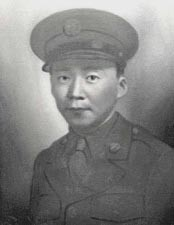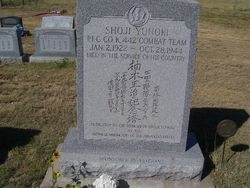
Shiyoji Yunoki
Private First Class
442nd Regimental Combat Team
3rd Battalion, K Company
Shiyoji Yunoki was born on January 2, 1922, in Sugar City, Crowley County, Colorado, to Jiroku and Chiye (Toji) Yunoki. He was the only son of eight children: his sisters were: Ikuta (died in infancy), Haruye, Akiko, Hattie, Mitzi Misao, and May.
Jiroku, also known as “Jimmy,” emigrated from Fukuoka Prefecture, Japan, arriving on July 27, 1906, in Vancouver, British Columbia, Canada, on the S.S. Athenian. He continued on to Crowley, Colorado, where his father Yaokichi, was farming beets and cantaloupes. Yaokichi had first arrived in the US from the village of Kaburi, Fukuoka Prefecture, in 1895. Jimmy went to work for his father on the farm, which was located one-half mile south of Crowley. In 1918, Jimmy went to San Francisco to meet his father and bride-to-be, Chiye Toji, who arrived on July 22 on the Tenyo Maru. Chiye was from the village of Nagaito, Fukuoka Prefecture. Jimmy and Chiye married in San Francisco before continuing on to Colorado.
Shoji, as Shiyoji was known, attended Crowley Elementary School and Crowley Junior High School. In 1930, the family was living with the widowed Yaokichi. In 1940, he graduated from Crowley High School, where he participated in baseball and was interested in photography. Shiyoji was in the Future Farmers of America (FFA) while in high school, and hoped to continue farming after high school.
On June 30, 1942, Shoji registered for the draft at Local Board No. 53 in Ordway, Colorado. He was self-employed as a farmer; his point of contact was his father. He was 5’5” tall and weighed 130 pounds.
Shoji enlisted in the U. S. Army on June 14, 1943, in Denver. He was sent to Camp Shelby, Mississippi, and assigned to the 442nd Regimental Combat Team, 3rd Battalion, K Company. After months of basic and unit training, the 442nd left Camp Shelby for Camp Patrick Henry, Virginia, on April 22, 1944. They shipped out to the Mediterranean Theater of Operations in a convoy of over one hundred ships on May 2, and arrived at Naples, Italy, on May 28.
Shoji fought in the Rome-Arno Campaign in Italy. The 442nd entered combat near Suvereto on June 26, 1944. After three months pushing the enemy north to the Arno River, the 442nd was taken off the line to prepare for movement to France. He went with his unit as they were sent to Marseilles, France on September 27 to join in the Rhineland-Vosges Campaign.
Third Battalion was moved from the staging area in Septèmes, just outside Marseilles, on October 10, by rail up the Rhone Valley and north to the Vosges. The train was an assortment of “40 and 8” boxcars. They arrived in the assembly area at Charmois-devant-Bruyères at midnight on October 13. At 2:00 p.m. the next day, the Combat Team began moving into position to attack the important rail and road center of Bruyères the following morning. After several days of intense fighting, the enemy had been cleared from the town and its surrounding hills, and on October 23, the 442nd was ordered to take the next town, Biffontaine. Finally on October 24, they were taken off the front lines and put in reserve in nearby Belmont for a rest after eight days of heavy fighting, little to no sleep, harsh weather conditions, and many casualties.
In the afternoon of October 26, the short rest was abruptly ended when the 442nd was ordered to go into the lines the next morning and fight through to rescue the 1st Battalion of the 141st (Texas) Infantry Regiment. After moving too fast and over-reaching its support, they had become surrounded on three sides by the enemy and were unable to extricate themselves. The 2nd and 3rd Battalions of the 141st Infantry Regiment, along with other units, had tried to rescue them, but were thrown back each time they attacked. The 442nd was given the assignment to rescue the “Lost Battalion.”
On October 27, 3rd Battalion moved out at 4:00 a.m. Their attack moved very slowly, meeting heavy resistance. At 3:30 p.m., K Company was counter-attacked and the fighting was severe. By evening, the Germans pulled back and 3rd Battalion did not pursue them as it was impossible to maintain control in the dark.
The following morning, October 28, the attack resumed against heavy resistance by the enemy. The 3rd Battalion ran into the first of a series of manned German roadblocks. These were primarily antitank barriers each manned by a company of infantry. At this point, K Company’s advance was stopped by enemy fire from several machine guns, riflemen, and grenadiers.
During this battle, Private First Class Shiyoji Yunoki was struck by a bullet and killed. He was one of seven K Company men killed that day.
After several days of severe fighting, on October 30 the Lost Battalion was rescued. It came at great loss for the 442nd, with very high casualties. K Company had lost all of its officers, I Company had only eight riflemen remaining, while K Company was down to only 25 riflemen. Normal full-strength complement consists of 150 riflemen in a company.
Pfc. Yunoki was interred in the U.S. Military Cemetery at nearby Epinal, France.
For his military service, Private First Class Shiyoji Yunoki was awarded the Bronze Star Medal, Purple Heart Medal, Good Conduct Medal, American Campaign Medal, European-African-Middle Eastern Campaign Medal with two bronze stars, World War II Victory Medal, Distinguished Unit Badge, and Combat Infantryman Badge. Shoji was awarded the Congressional Gold Medal on October 5, 2010, along with the other veterans of the 100th/442nd Regimental Combat Team. This is the highest Congressional Civilian Medal.

In 1948, the remains of Americans buried overseas began slowly to return to the US, if the family so wished. According to his family’s wish, Shoji was brought home. He was reinterred in Valley View Cemetery, Ordway, Crowley County, Colorado.
Right: Yunoki’s tombstone in Valley View Cemetery
His tombstone was sponsored by veterans and is inscribed, “Died in the Service of his Country – Dedicated to the Memory of Shoji Yunoki by the Japanese Americans of the Arkansas Valley.”
Pfc. Yunoki’s name appears on the Colorado Freedom Memorial, located in Aurora, on Panel 8, Column 4, Row 11.
Researched and written by the Sons & Daughters of the 442nd Regimental Combat Team in 2022.
